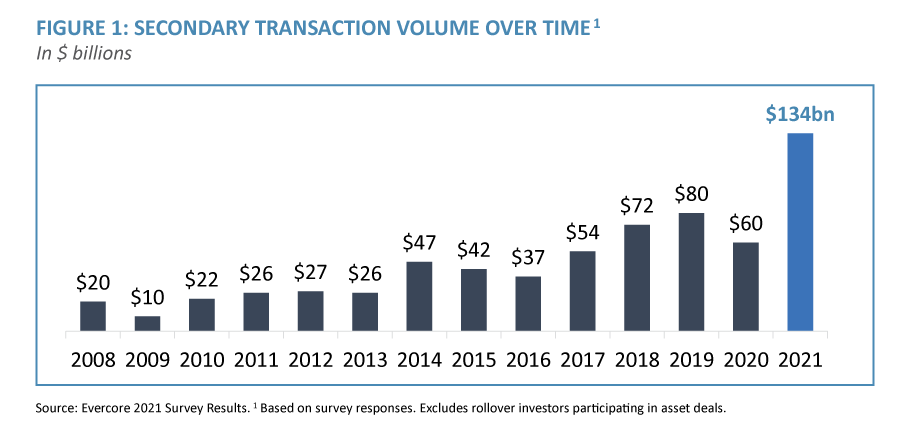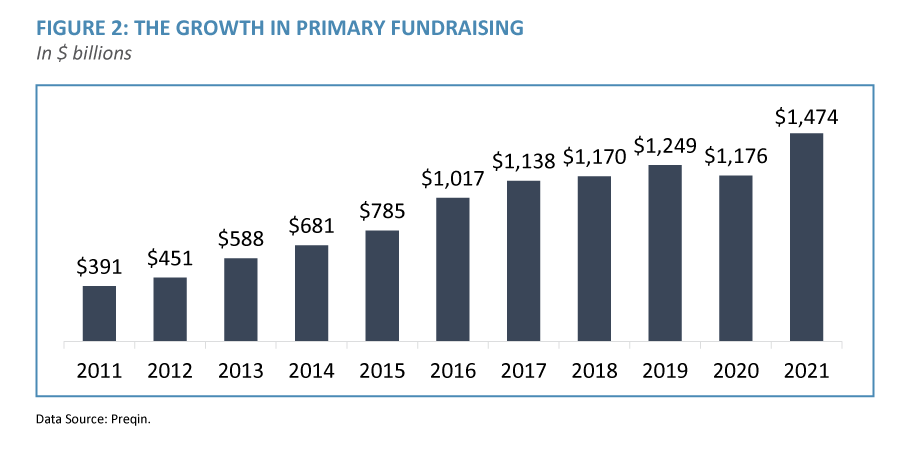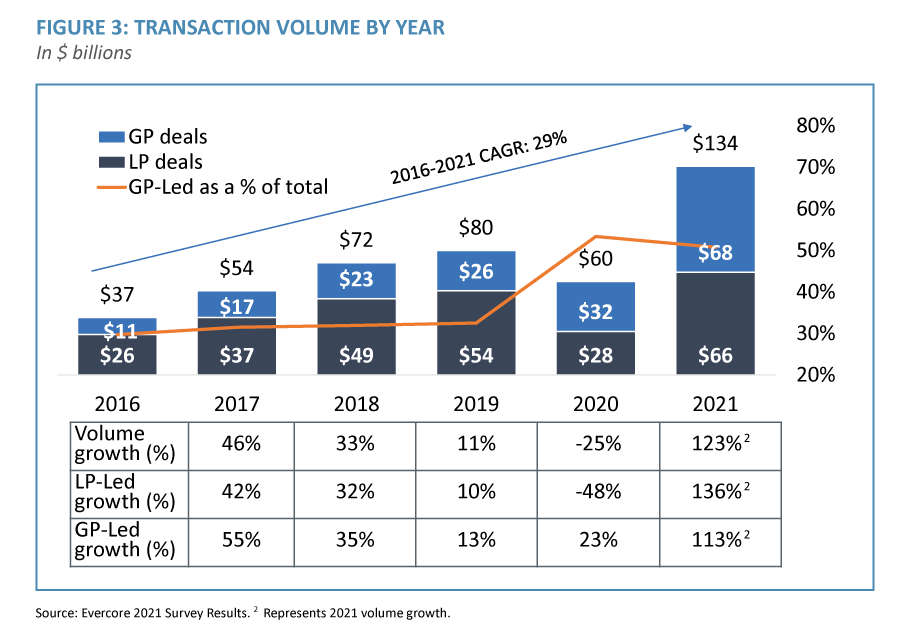How Will the Secondary Market React to Persistent Volatility?

Select risks include risks related to the lack of a liquid, transparent market for secondary investments, performance risk, and risks related to sourcing investments.
Key Takeaways
- Market volatility caused a modest slowdown in LP secondary transaction volume during Q2 2022, but we do not expect the slowdown to last long.
- When looking at previous times of economic stress, secondary deal volume has shown a pattern of declining during the initial shock but rebounding to record volumes shortly after.
- The potential of sustained market volatility and economic uncertainty could further accelerate the rise of the GP-led market.
- We expect to see a trend toward continuation funds as sponsors continue to appreciate the benefits of holding on to high quality assets for longer and secondary investors gain access to high quality assets and sponsors at attractive valuations.
- Given market conditions, we believe investors should focus on deals that involve companies that are in non-cyclical industries, have less reliance on consumer discretionary spend, and have attractive financial attributes.
The investment landscape continues to evolve at an accelerated pace. Below, we address some of our clients’ most-often asked questions regarding secondary transactions in the current environment and discuss what we expect to see going forward.
Q: How has the current market volatility and economic uncertainty impacted secondary deal volume thus far, and what do you expect to see going forward?
Secondary transaction volume has been robust and growing rapidly since 2016. Transaction volume had a temporary decline in 2020 because of the COVID-19 pandemic, but quickly rebounded to record levels in 2021. Throughout Q1 2022, market growth continued with the acceleration of both LP and GP-Led transactions.
As market volatility and uncertainty increased during Q2, market volume growth did slow, particularly on the LP side where certain sellers put a temporary pause on potential transactions. Many are planning to revisit them later this year once NAVs catch up to reflect the current environment.
We do not expect the slowdown in secondary transaction volume to last long. In fact, to help understand what is likely to happen to secondary deal volume in a persistently volatile market backdrop, we can look back at past moments of volatility and the associated secondary market reaction.
During the Global Financial Crisis, secondary transaction volume briefly declined before accelerating again. As illustrated in figure 1, we saw a similar behavioral pattern again in 2020 as deal volume declined due to the COVID-19 pandemic only to pick up and end 2021 with more than double the deal volume of 2020 and 65% more volume than 2019.

During periods of market volatility or economic recession, institutions often value liquidity and financial flexibility. The secondary market is one of the main avenues that can provide liquidity to institutional investors, and therefore we believe deal activity in the coming years will increase as previously seen following times of economic stress.
We also expect to see increased selling volume over the next 1-3 years due to the amount and pace of primary fundraising. As seen below, the amount of capital raised for private equity primary funds has more than tripled over the last ten years. Because the secondary market is a natural derivative of the primary market, we believe the continued growth in primary fundraising will naturally lead to increased secondary transaction volume as investors continue to manage their private equity investments.

Q: What do you expect to see in the GP-led market over the next 1-3 years?
The GP-led market has exploded in the past several years as both sponsors and investors recognize the benefits of these transactions. While previously just a small portion of total deal volume, GP-led deals have increased from approximately $11 billion in 2016 to almost $70 billion in 2021 and now comprise about 50% of the overall secondary market as seen in figure 3 below.

We believe the potential of sustained market volatility and economic uncertainty could further accelerate the rise of the GP-led market. Sponsors recognize that uncertain economic conditions might not allow them to maximize value through a traditional exit route such as an M&A or IPO, so continuation funds are often viewed as an attractive alternative. By pursuing this strategy, sponsors can hold on to their best performing assets while also offering liquidity to their underlying LPs.
Q: What key areas should investors be focusing on as the investment landscape continues to rapidly evolve?
In times of economic uncertainty, we believe the focus should be on deals that involve companies that are in non-cyclical industries, have less reliance on consumer discretionary spend, and have attractive financial attributes (low capex, high free cash flow conversion, flexible capital structure, etc.). For example, a continuation fund allows a potential investor to perform a deep level of due diligence on the underlying company and its industry to assess the company’s ability to withstand a recessionary environment. Sponsors are also incentivized to choose their best assets for continuation funds since they will commit substantial capital, usually in the form of rolled carried interest, alongside the secondary buyers. We expect the GP-led market to continue to be a large and growing percentage of the overall secondary market going forward, with a trend toward continuation funds as they can provide a strong opportunity for investors to gain access to high quality assets and sponsors at attractive valuations.
It also goes without saying that purchase price remains a key deal consideration, especially considering the volatility in the public markets and the changing economic outlook. We are seeing many deals get repriced as buyers try to account for the changing pricing environment. Sponsor carrying values, which often lag by a quarter, can provide a distorted reference during periods of market volatility so buyers should be wary about using them as a reference point and instead conduct thorough, independent due diligence.
Conclusion
While LP secondary volume saw a slight decline in Q2 2022, we expect the slowdown to be temporary and believe volume will increase over the coming quarters and years as sellers continue to prioritize liquidity in their portfolios.
We are also seeing many sponsors continue to pursue alternatives to traditional exit routes, such as continuation funds. These structures can be an appealing option for investors as they can provide access to high quality sponsors and assets at attractive valuations. They also allow for a deep level of due diligence, which can help investors assess many critical factors about the assets’ growth potential including the ability to withstand a potentially persistent volatile market.
At GCM Grosvenor, we are well positioned to take advantage of the expected increase in volume in both LP transactions and GP-led transactions. We continue to emphasize transactions where the underlying companies are market leaders with compelling financial characteristics, multiple growth levers to drive value at exit, strong performance under the sponsor’s ownership to date, and high capital efficiency.
Read more about our private equity platform including our secondaries capabilities.
Important disclosures
Investments in alternatives are speculative and involve substantial risk, including risks related to the lack of a liquid, transparent market for secondary investments, performance risk, and risks related to sourcing investments, and may result in the possible loss of your entire investment. Past performance is not necessarily indicative of future results. The views expressed are for informational purposes only and are not intended to serve as a forecast, a guarantee of future results, investment recommendations or an offer to buy or sell securities by GCM Grosvenor. All expressions of opinion are subject to change without notice in reaction to shifting market, economic, or political conditions. The investment strategies mentioned are not personalized to your financial circumstances or investment objectives, and differences in account size, the timing of transactions and market conditions prevailing at the time of investment may lead to different results. Certain information included herein may have been provided parties not affiliated with GCM Grosvenor. GCM Grosvenor has not independently verified such information and makes no representation or warranty as to its accuracy or completeness.

